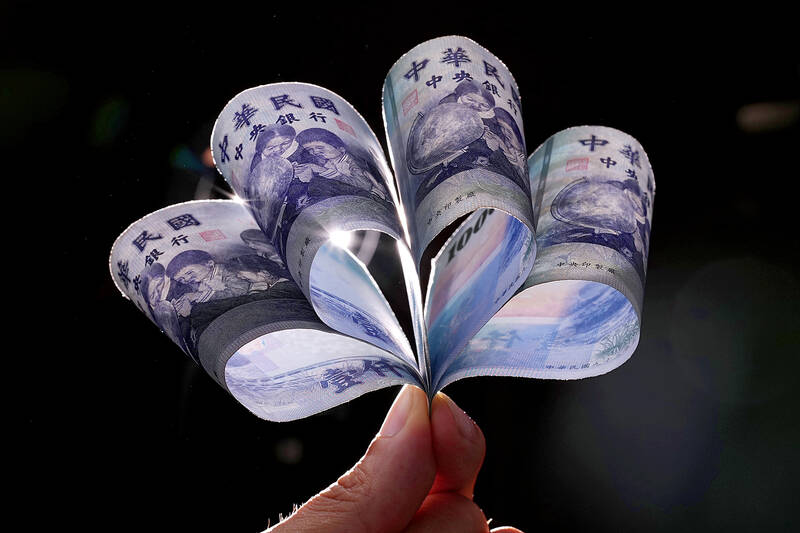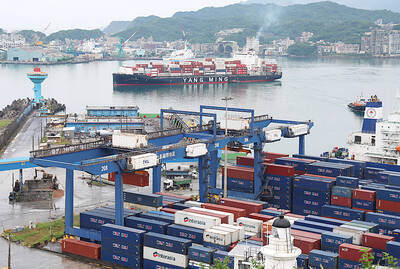A surging New Taiwan dollar is proving a double-edged sword for the economy, undermining export competitiveness while helping lower import costs, a familiar dilemma for domestic exporters, the central bank said yesterday, as the local currency has risen more than 10 percent against the US dollar this year.
Taiwan has weathered similar cycles, central bank Deputy Governor Yen Tzung-ta (嚴宗大) said at a meeting of the legislature’s Economics Committee, citing the 2019–2022 period when the NT dollar appreciated to NT$27.532 against the greenback.
Despite that, exports jumped 13.9 percent as GDP grew 4.3 percent, outperforming most major economies, thanks to remote working and schooling during the COVID-19 pandemic driving tech demand Yen said.

Photo: CNA
The local currency’s strength this year reflects robust export momentum, driven by booming demand for chips and electronics used in artificial intelligence (AI) applications, even as global markets assess the implications of US President Donald Trump’s evolving tariff policy, he said.
The NT dollar closed at NT$29.391 against the US dollar in Taipei trading yesterday, having gained 12.3 percent since April, central bank data showed.
A stronger currency is not entirely a burden, as many manufacturers import raw materials, Yen said.
“A strong NT dollar helps lower input costs, which can help protect profit margins,” he said.
From 2015 to 2021, Taiwanese listed companies recorded NT$116.7 billion (US$3.97 billion) in foreign exchange losses, but from 2022 to last year, they posted NT$474.9 billion in foreign exchange gains, yielding a net benefit of NT$358.2 billion, he said.
Despite recent volatility, the NT dollar remains relatively stable compared with other currencies, such as the yen, euro and won, he said.
Many firms also manage their foreign exchange exposure through forward contracts or natural hedging strategies, limiting their vulnerability to short-term swings, he said.
Taiwanese exporters can adapt by raising prices, shifting orders, and emphasizing high-margin or value-added products, he said.
Over the longer term, they are diversifying their markets and supply chains to build resilience, he added.
“Past experience shows that Taiwan has a certain degree of resilience to currency appreciation,” he said.
The central bank remains committed to maintaining stability in the foreign exchange market, he said.
It does not need to intervene aggressively to meet that goal, but stands ready to adjust policy if needed to keep the currency relatively stable against global peers, he said.
Moreover, the central bank is closing monitoring foreign capital flows to prevent speculative currency plays through inverse exchange-traded funds (ETFs), he said.
To curb such risks, the central bank and the Financial Supervisory Commission reached a consensus as early as 2020, capping foreign investors’ holdings of inverse ETFs at 30 percent of total issuance, he said.
Yen said the central bank monitors foreign activity daily and would swiftly order capital outflows if it detects currency speculation, in line with what he described as a “guest eviction order.”

CHIP RACE: Three years of overbroad export controls drove foreign competitors to pursue their own AI chips, and ‘cost US taxpayers billions of dollars,’ Nvidia said China has figured out the US strategy for allowing it to buy Nvidia Corp’s H200s and is rejecting the artificial intelligence (AI) chip in favor of domestically developed semiconductors, White House AI adviser David Sacks said, citing news reports. US President Donald Trump on Monday said that he would allow shipments of Nvidia’s H200 chips to China, part of an administration effort backed by Sacks to challenge Chinese tech champions such as Huawei Technologies Co (華為) by bringing US competition to their home market. On Friday, Sacks signaled that he was uncertain about whether that approach would work. “They’re rejecting our chips,” Sacks

Taiwan’s exports soared 56 percent year-on-year to an all-time high of US$64.05 billion last month, propelled by surging global demand for artificial intelligence (AI), high-performance computing and cloud service infrastructure, the Ministry of Finance said yesterday. Department of Statistics Director-General Beatrice Tsai (蔡美娜) called the figure an unexpected upside surprise, citing a wave of technology orders from overseas customers alongside the usual year-end shopping season for technology products. Growth is likely to remain strong this month, she said, projecting a 40 percent to 45 percent expansion on an annual basis. The outperformance could prompt the Directorate-General of Budget, Accounting and

NATIONAL SECURITY: Intel’s testing of ACM tools despite US government control ‘highlights egregious gaps in US technology protection policies,’ a former official said Chipmaker Intel Corp has tested chipmaking tools this year from a toolmaker with deep roots in China and two overseas units that were targeted by US sanctions, according to two sources with direct knowledge of the matter. Intel, which fended off calls for its CEO’s resignation from US President Donald Trump in August over his alleged ties to China, got the tools from ACM Research Inc, a Fremont, California-based producer of chipmaking equipment. Two of ACM’s units, based in Shanghai and South Korea, were among a number of firms barred last year from receiving US technology over claims they have

BARRIERS: Gudeng’s chairman said it was unlikely that the US could replicate Taiwan’s science parks in Arizona, given its strict immigration policies and cultural differences Gudeng Precision Industrial Co (家登), which supplies wafer pods to the world’s major semiconductor firms, yesterday said it is in no rush to set up production in the US due to high costs. The company supplies its customers through a warehouse in Arizona jointly operated by TSS Holdings Ltd (德鑫控股), a joint holding of Gudeng and 17 Taiwanese firms in the semiconductor supply chain, including specialty plastic compounds producer Nytex Composites Co (耐特) and automated material handling system supplier Symtek Automation Asia Co (迅得). While the company has long been exploring the feasibility of setting up production in the US to address